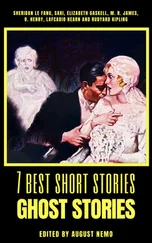Warner never felt the need to address the fact that she was living with a woman. This attitude is apparent in the passing remarks she makes about her lesbian relationship in her private letters, and can be seen in the way she features male homoeroticism in her stories. Her unbiased acceptance of sexual desire was one of the main reasons why she was asked to write the biography of T.H. White: “In addition to the affinity for fantasy she shared with White, Warner had been chosen as his biographer in part because White’s closest friends trusted her, as a sexual dissident, to tell his tale generously, openly, and without judgement” (Micir 124). Writing White’s biography presented Warner with a challenge. She realised that she could not disclose too much information about his sexuality without causing a scandal and decided to omit several details.
By contrast, Warner’s stories have never been subject to any moral censorship. In “The Shirt in Mexico” (1941), “The Green Torso” (1970), and “Bruno” (1971), Warner writes freely about homoeroticism and cross-generational longings. Despite the considerable time span between the writing of these stories, all three take a similar stance on homoerotic desires: rather than positioning themselves in opposition to normative or non normative desires, they explore the particularities of desire as such. They reflect on the porosity of boundaries, describe materials that stimulate desire, and investigate the role played by inanimate objects in deriving pleasure. The chapter begins with an analysis of “The Shirt in Mexico” (1940), followed by “Bruno” (1971), and “The Green Torso” (1971).
2.1 “The Shirt in Mexico”: Gender Disruption and Ambiguous Speech
“The Shirt in Mexico” first appeared in The New Yorker on 4 January 1941 and was later included in the collection of short stories A Garland of Straw (1943) under the title “My Shirt is in Mexico”. Warner wrote and published this story at a time in which homosexual acts between men were still considered a crime in the United Kingdom (lesbianism was never considered worthy of any legal consideration). The story revolves around an intimate conversation between the narrator, the narrator’s friend Valentine, and a train attendant. During this conversation, the train attendant tells the story of how he once met a man on the train with a very distinctive taste in clothes. This chapter analyses the sexual character of the language used by the different interlocutors and explores the connection between touch, textiles, and desire. It questions the art of gifting and examines the effect of the train attendant’s gift on the train passenger.
“But the buffet car was almost empty and looked like something belonging to a different world, with its clean, light-painted walls and red leather upholstery” (Warner, “The Shirt in Mexico” 51). Coming from the passenger compartments, the unnamed narrator and Valentine are described entering the buffet car of the train. The transition from one space to another is almost uncanny, since the cabin they enter is completely different to the cabin they have just left (“The train was crammed, a wartime train loaded with soldiers […]”, “It was difficult to move along the corridor, one had to edge one’s way past soldiers sitting on their packs […]”, 51). All of a sudden, they find themselves more-or-less alone in the empty compartment of an otherwise overcrowded train. In this compartment, the signs of war are less visible. The shift of scene gives rise to an extraordinary conversation revolving around homoerotic desires.
Prompted by the narrator’s Mexican-inspired bag, “which was printed with a gay view of flowers and white-clothed tourists riding on festooned mules”, the buffet car attendant starts conversing with the two passengers: ‘“[…] Oh, I’d like to go to Mexico. It must be beautiful… I’ve got a shirt in Mexico,’ he said” (51). Up until this point, the three interlocutors were merely making small talk. The attendant’s last remark, however, prompts the two passengers to elicit further details. The attendant tells them: “It all happened before the war, because of a German gentleman, a refugee. I noticed him the moment he came in […] and I thought to myself, Now, he’s somebody” (51). The German instantly catches the attendant’s eye, “A bald man, and thin as a lath, and most remarkably clean”, and he recalls how he was determined to learn more about him (52).1
After serving the German cake and a cup of coffee, the attendant carefully approaches him again under the pretence of changing the ashtray. He tells the narrator and Valentine, “‘When I went to change it [the ashtray], he said he didn’t smoke. Now, I don’t smoke either, so that was a beginning. And once you’ve got a beginning, it’s easy, isn’t?’” (52). He does not hide the fact that he felt attracted to the German and desired to talk to him. His present audience, the narrator and Valentine, do not consider his behaviour inappropriate or odd in any way. They carry on listening to his story. Critics such as Gay Wachman attribute this to the fact that the narrator and Valentine are also gay. Wachman biographies “The Shirt in Mexico” and argues that the attendant knows that he is talking to a lesbian couple – namely, to the fictional versions of Sylvia Townsend Warner and her partner, Valentine Ackland. Based on this reading, Wachman writes, “No wonder the attendant looked at the two women ‘as though [they] were friends of his’ when he first brought them their drinks; he was responding, whether consciously or not, to their lesbian intimacy” (Wachman, “Lesbian Political History” 314). Given Warner’s biography, “The Shirt in Mexico” does lend itself to such an analysis. However, this in turn simultaneously rules out any form of ambiguity and unmistakably defines the characters’ genders and desires. As a result, the story loses its light, oscillatory quality.
Like Wachman, Frances Bingham combines close-reading with biographical criticism. Bingham, however, does not seek to unravel the ambiguities displayed in the story. Like Wachman, Bingham identifies the narrator as Sylvia Townsend Warner and the narrator’s friend as Valentine Ackland. At the same time, however, Bingham draws attention to the fact that the story does not gender Valentine and that the name “Valentine” is generally considered to be male. Bingham writes,
A character actually named Valentine is introduced in ‘My shirt is in Mexico’, and remains carefully ungendered throughout. […] Ackland’s presence is not explained, her place as an intimate companion of the narrator is taken as inevitable. She is named but, as Warner knew from experience, the name was usually presumed to be masculine; no pointers in the text confirm this, not does anything disprove it. The reader’s own preconception, or foreknowledge, is delicately unstated by Warner. (36)
Bingham emphasises the fact that Warner does not seek to confirm Valentine’s gender in any way – neither for readers aware of Valentine Ackland’s existence, nor for unaware readers. On the basis of the gender commonly ascribed to the name “Valentine”, and without any knowledge of Warner’s biography, the Valentine in the story is more likely to be taken to be male than female. Conversely, there are no personal or possessive pronouns or any other form of address to confirm this assumption.
Whilst Valentine’s gender remains ambiguous, there can be little doubt about the narrator’s gender. By addressing her as “Madam”, the attendant discloses that the narrator is female (‘“Excuse me mentioning it, Madam, but I see from your bag you’ve been to Mexico”, 51). Yet, even if Valentine were male, this would not automatically mean that the narrator and Valentine were in a heterosexual relationship; and if she were female, this would not automatically mean that they were in a homosexual relationship. The narrator merely refers to Valentine as her friend (“As soon as the train left London, my friend Valentine and I went along to the buffet car for a drink”, 51) and not as her companion, lover or partner. She deliberately obscures her relationship with Valentine. In a reading in which Valentine is male and not in a relationship with the narrator, the attendant, a gay male, can talk openly to anyone he trusts about his homoerotic desires. In this reading, a person’s gender and the gender of their object of desire is of little significance.
Читать дальше












